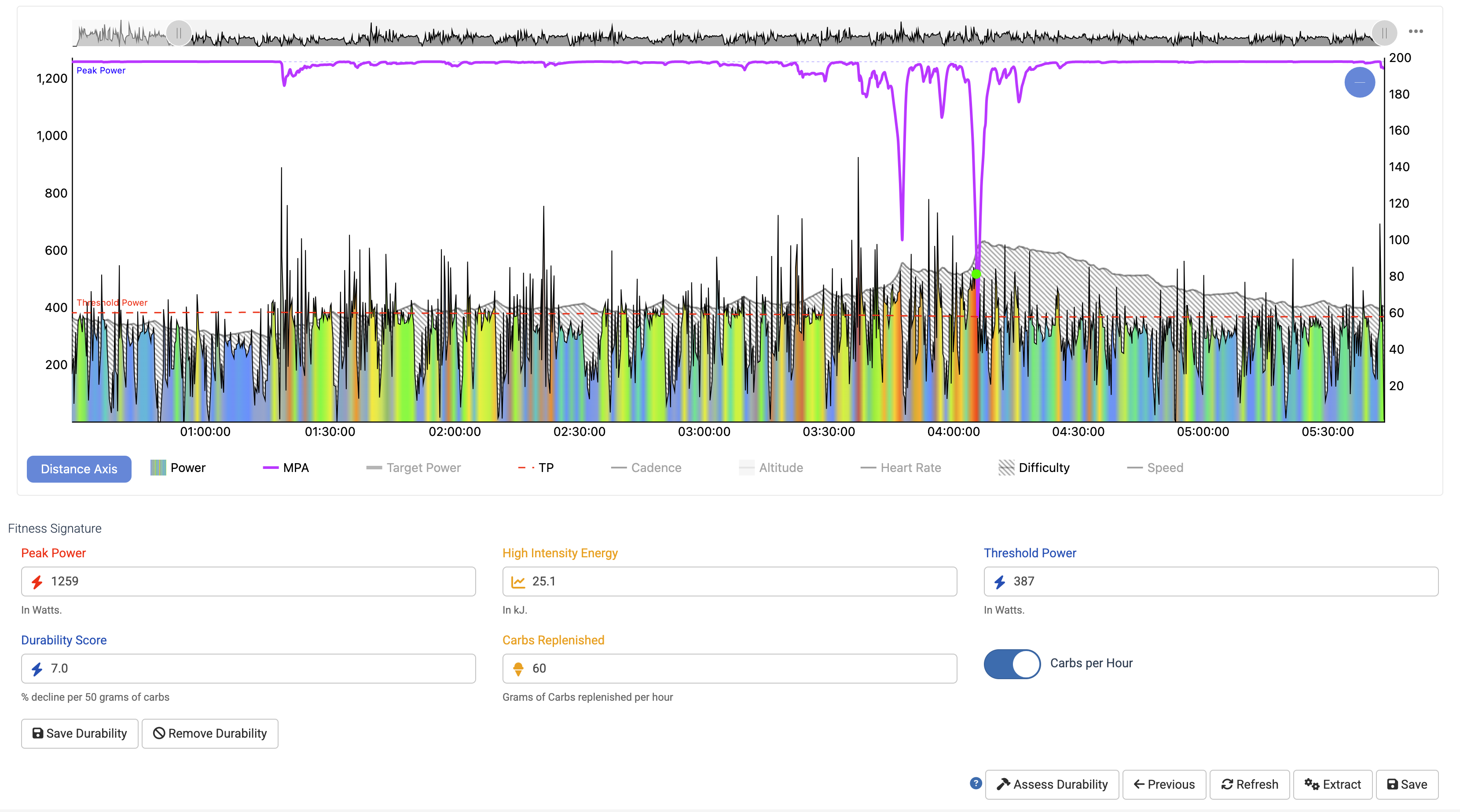Durability Score is an assessment of the effect on your fitness signature after hours of riding/exercise/activity. Xert normally evaluates your fitness signature as a single set of 3 values that do not change over the course of an activity. When durability is included, your fitness signature changes over the course of the activity.
How to Use Durability Score
To properly assess durability scores, you should choose activities that are longer than 3 hours and activities where you know you felt you were at your limit after 3 or more hours. This could be from a final climb during a race and all-out 3 minute TT, for example. Just feeling tired at the end isn’t enough to assess durability. A max effort while fatigued from a long ride is necessary. Note that if you had a breakthrough during the activity, you may not be able assess your durability.
Steps:
- Locate an activity that is more than 2 hours long. Often a race is a good candidate.
- Determine / try to recall if you had a maximal effort towards the end of the ride/race.
- Ensure you didn’t have breakthough during the event. This makes it difficult for the system to assess how your fitness signature changed during the activity.
- The system has identified a good representative fitness signature for you at the start of that ride/race. An over/under estimate can impact the assessment. Note any potential effects from your chosen Signature Decay.
- Click the Assess Durability button
- (Optional) If using Carbs Used as your Durability Metric, input the Carbs Replenished either as a total or as a per hour values. Assess Durability again.
- Click the Save Durability button if the assessment appears to be a realistic interpretation of the changes in your fitness signature.
How it Works
When you click Assess Durability, the system will calculate your Durability Metric, second-by-second over the course of the activity and associate a decline in your fitness signature as a function of this metric. The score is then shown as well as your fitness signature at each point in the activity. Simpy mouse over the TP line to see the signature at the point in time:
The MPA line we be noticeably different as it will now track your longer-term fatigue / slow-recovery fatigue / durability over the course of the ride. This type of fatigue does not recover during the ride and will require full rest. In most cases, this fatigue can be attributed to glycogen depletion, i.e. your energy stores needed for higher intensity have become depleted and your ability to sustain longer efforts above threshold are diminished. Indeed, your Threshold Power erodes during the course of the event/activity. You can see the effect of this by mousing over the TP line on the chart to see how your fitness signature changes.
How to Evaluate your Durability Score
Durablity Scores tend to range between 15% and under 5%, with 15% being untrained and under 5% being professional level. Club level well-trained athletes can be at 10% or lower. Those that win races will have better durability scores during these races as compared to their competition. Winners of professional races, for example, can combine the highest fitness signature values together with durability scores less than 2%. Indeed, those with better durability scores can outperform stronger athletes (those with a better fitness signature) but with weaker durability. Often a strategy of increasing the paces to impact durability of part of the strategy.
The concept of Durability has long been part of endurance sport. The word endurance itself is associated with durability, having the same etymology, being from Latin “indurare” which means to make hard.
When Xert was first developed, durability was part of the architecture. Looking at the original post on Fitness Signatures, published in December of 2014, we described the concept of “Slow Recovery Fatigue”. This is ostensibly durability. It describes how your power duration curve changes over the course of a very long event. We used this phenomenon to help define our concept of Lower Threshold Power. which became a core part of Xert. This was long before Zone 2 training became a fad … and now it’s Durability which has become quite prominent within training and coaching circles, especially at the elite and professional levels.
We had intended to make durability a feature in Xert for many years but always ran into challenges associated with the complexity of the computational requirements and the limitations due things like fueling times and rates, which is data that is not readily available. However, we eventually envisioned a way to make “slow recovery fatigue” i.e. “durability”, part of the system. This is the Durability Score feature.

